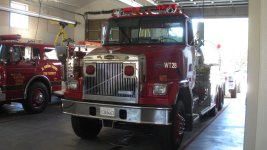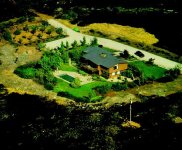Larry Caldwell
Super Member
With all the homes burning, it occurred to me that people who don't normally live in a wildfire area might not know what they should do to preserve their house.
1 - The first thing to do is clean your gutters. During dry weather, the duff in the bottom of the gutter turns into tinder. A single spark will light it, and the fire will burn up under the roofing and catch the roof sheathing on fire.
2 - Cedar shake roofs are a bad choice. The best roof for a house in wildfire areas is metal. Second comes any other class A fire resistive roofing, like vitreous tile (bad choice in a hailstorm) or asphalt composition shingles.
3 - Establish a 50 foot defensible space around the house that contains nothing that will flare. Green grass is OK, dry grass not. No oily shrubs like juniper or cedar. No trees within tree height of the house, and remember, that 50 foot pine will be a 100 foot pine someday. Essentially, no fuel stored wihin 50 feet of the house, and no trees or branches that can fall on the house.
4 - Build a driveway that a fire engine can get down. Your local fire department (if you have one) can give you the specifications.
5 - Store fire fighting water. My county requires 1500 gallons on-site storage anywhere a hydrant is not available. You can buy a 2500 gallon spun poly tank for about $800, and that is more water than a fire department tanker hauls. You don't have to have a swimming pool to have on-site water.
6 - Plan your escape. Leave it to the fire department to save your house. Nothing stands in front of a wind driven wildfire. Sometimes the best thing you can do is run.
1 - The first thing to do is clean your gutters. During dry weather, the duff in the bottom of the gutter turns into tinder. A single spark will light it, and the fire will burn up under the roofing and catch the roof sheathing on fire.
2 - Cedar shake roofs are a bad choice. The best roof for a house in wildfire areas is metal. Second comes any other class A fire resistive roofing, like vitreous tile (bad choice in a hailstorm) or asphalt composition shingles.
3 - Establish a 50 foot defensible space around the house that contains nothing that will flare. Green grass is OK, dry grass not. No oily shrubs like juniper or cedar. No trees within tree height of the house, and remember, that 50 foot pine will be a 100 foot pine someday. Essentially, no fuel stored wihin 50 feet of the house, and no trees or branches that can fall on the house.
4 - Build a driveway that a fire engine can get down. Your local fire department (if you have one) can give you the specifications.
5 - Store fire fighting water. My county requires 1500 gallons on-site storage anywhere a hydrant is not available. You can buy a 2500 gallon spun poly tank for about $800, and that is more water than a fire department tanker hauls. You don't have to have a swimming pool to have on-site water.
6 - Plan your escape. Leave it to the fire department to save your house. Nothing stands in front of a wind driven wildfire. Sometimes the best thing you can do is run.

